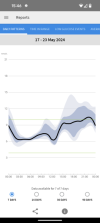Nell83
Active Member
- Relationship to Diabetes
- Type 2
- Pronouns
- She/Her
Hi all,
Since starting insulin in March I've cut out all refined sugars from my diet but I'm now finding if I eat anything with carbohydrates in I have a massive spike usually 5-8mmol from pre-meal reading. I'm using a libre 2 (self funded) to try and help with educating myself about what has an impact and what doesn't.
I have to travel a lot for work and occasionally have to grab a sandwich to eat on the run and these have caused massive spikes of up to 10mmol after 2 hours.
As a picky eater I have relied on beige food all my life - cutting carbs has been really difficult for me.
Am I better looking at time in range which is around 80% between 4-10mmol? at the moment I feel like I'm on a rollercoaster! I'm also exhausted all the time - is this likely to be because my sugars are up and down so much?
Since starting insulin in March I've cut out all refined sugars from my diet but I'm now finding if I eat anything with carbohydrates in I have a massive spike usually 5-8mmol from pre-meal reading. I'm using a libre 2 (self funded) to try and help with educating myself about what has an impact and what doesn't.
I have to travel a lot for work and occasionally have to grab a sandwich to eat on the run and these have caused massive spikes of up to 10mmol after 2 hours.
As a picky eater I have relied on beige food all my life - cutting carbs has been really difficult for me.
Am I better looking at time in range which is around 80% between 4-10mmol? at the moment I feel like I'm on a rollercoaster! I'm also exhausted all the time - is this likely to be because my sugars are up and down so much?

